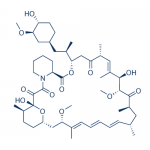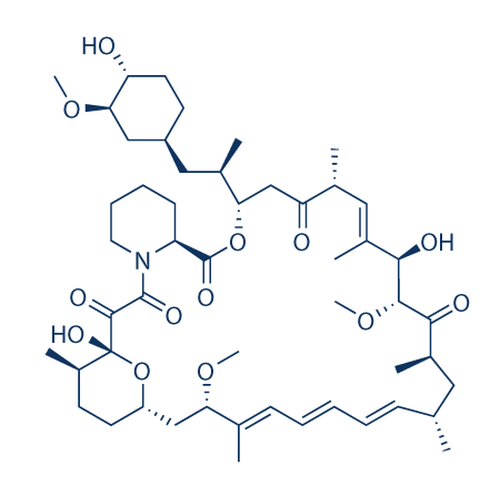| Product Name | Rapamycin |
| Description |
mTOR inhibitor |
| Purity | >98% |
| CAS No. | 53123-88-9 |
| Molecular Formula | C51H79NO13 |
| Molecular Weight | 914.18 |
| Field of Use | Not for use in humans. Not for use in diagnostics or therapeutics. For in vitro research use only. |
Properties
| Storage Temperature | -20ºC |
| Shipping Temperature | Shipped Ambient |
| Product Type | Inhibitor |
| Solubility | Soluble to 100 mM in ethanol, and to 50 mM in DMSO |
| Source | Synthetic |
| Appearance | White Solid |
| SMILES | C[C@@H]1CC[C@H]2C[C@@H](/C(=C/C=C/C=C/[C@H](C[C@H](C(=O)[C@@H]([C@@H](/C(=C/[C@H](C(=O)C[C@H](OC(=O)[C@@H]3CCCCN3C(=O)C(=O)[C@@]1(O2)O)[C@H](C)C[C@@H]4CC[C@H]([C@@H](C4)OC)O)C)/C)O)OC)C)C)/C)OC |
| InChI | InChI=1S/C51H79NO13/c1-30-16-12-11-13-17-31(2)42(61-8)28-38-21-19-36(7)51(60,65-38)48(57)49(58)52-23-15-14-18-39(52)50(59)64-43(33(4)26-37-20-22-40(53)44(27-37)62-9)29-41(54)32(3)25-35(6)46(56)47(63- |
| InChIKey | QFJCIRLUMZQUOT-HPLJOQBZSA-N |
| Safety Phrases |
Classification: Harmful. May be harmful if inhaled, swallowed or absorbed through skin. Safety Phrases: S22 - Do not breathe dust S24/25 - Avoid contact with skin and eyes S36/37/39 - Wear suitable protective clothing, gloves and eye/face protection Risk Phrases: R68- Possible risk of irreversible effect |
| Cite This Product | Rapamycin (StressMarq Biosciences Inc., Victoria BC CANADA, Catalog # SIH-212) |
Biological Description
| Alternative Names | (1R,9S,12S,15R,16E,18R,19R,21R,23S,24E,26E,28E,30S,32S,35R)-1,18-Dihydroxy-12-{1-[(1S,3R,4R)-4-hydroxy-3-methoxycyclohexyl]-2-propanyl}-19,30-dimethoxy-15,17,21,23,29,35-hexamethyl-11,36-dioxa-4-azatr icyclo[30.3.1.04,9]hexatriaconta-16,24,26,28-tetraene2,3,10,14,20-pentone |
| Research Areas | Apoptosis, Cancer, Cancer Growth Inhibitors, mTOR Inhibitors |
| PubChem ID | 5284616 |
| Scientific Background | Rapamycin (Sirolimus) is an immunosuppressant that inhibits the mTOR pathway by binding FKBP12. In neurodegenerative disease research, rapamycin is explored for its ability to modulate autophagy, reduce protein aggregation, and improve cognitive function. It holds promise in the treatment of Alzheimer’s disease, autism, and other neurodevelopmental disorders. |
| References |
1. Gruppuso P.A., Boylan J.M., and Sanders J.A. (2011) Cell Cycle. 10(7): EPub. 2. Ehninger D., et al. (2008) Nat. Med. 14(8): 843-848. 3. Donia M., McCubrey J.A., Bendtzen K., and Nicoletti F. (2010) Br J Clin Pharmacol. 70(6): 784-793. |



Reviews
There are no reviews yet.